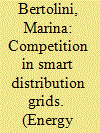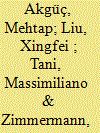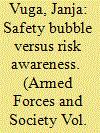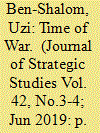|
|
|
Sort Order |
|
|
|
Items / Page
|
|
|
|
|
|
|
| Srl | Item |
| 1 |
ID:
174955


|
|
|
|
|
| Summary/Abstract |
Smart grids are often considered a cornerstone of energy transition and market liberalization in electric industries. From a critical reading of the interdisciplinary academic and governmental literature, we draw a new definition of grid smartness that is based on the reduction of the volatility of market prices and flows. Then, relying on a simple industrial-organization model of the electric market, we analyze the impact of smart grids on competition among energy suppliers and on the incentives of distribution system operators to invest in it. We show that the risk-reduction effect of smart grids pushes firms to supply more energy. However, the latter can be compensated by an indirect competition effect of investments in smart grids which prevents the entry of firms into the market, though the aggregate effect on energy supply is always positive. We also find that distribution system operators under-invest in smart grids because they fail to internalize positive externalities on energy consumers and producers.
|
|
|
|
|
|
|
|
|
|
|
|
|
|
|
|
| 2 |
ID:
150426


|
|
|
|
|
| Summary/Abstract |
Recently, the estimation of accident costs within the social costs of nuclear power plants (NPPs) has garnered substantial interest. In particular, the risk aversion behavior of the public toward an NPP accident is considered an important factor when integrating risk aversion into NPP accident cost. In this study, an integrated framework for the external cost assessment of NPP accident that measures the value of statistical life (VSL) and the relative risk aversion (RRA) coefficient for NPP accident based on an individual-level survey is proposed. To derive the willingness to pay and the RRA coefficient for NPP accident risks, a survey was conducted on a sample of 1550 individuals in Korea. The estimation obtained a mean VSL of USD 2.78 million and an RRA coefficient of 1.315. Based on the estimation results in which various cost factors were considered, a multiplication factor of 5.16 and an external cost of NPP accidents of 4.39E−03 USD-cents/kW h were estimated. This study is expected to provide insight to energy policy decision-makers on analyzing the economic validity of NPP compared to other energy sources by reflecting the estimated external cost of NPP accident into the unit electricity generation cost of NPP.
|
|
|
|
|
|
|
|
|
|
|
|
|
|
|
|
| 3 |
ID:
147419


|
|
|
|
|
| Summary/Abstract |
To contribute to a scarce literature, in particular for developing and emerging economies, we study the nature of measured risk attitudes and their consequences for migration. We also investigate whether substantial changes in the risk environment influence risk tolerance. Using the 2009 RUMiC data for China, we find that rural–urban migrants and their family members are substantially less risk-averse than stayers. We further provide suggestive evidence that individual risk attitudes are unaffected by substantial changes in the environment and that risk tolerance is correlated across generations.
|
|
|
|
|
|
|
|
|
|
|
|
|
|
|
|
| 4 |
ID:
088022


|
|
|
|
|
| Publication |
2009.
|
| Summary/Abstract |
This article evaluates the impact of the 2006 compliance event on changes in investors' risk aversion on the European carbon market using the newly available option prices dataset. Thus, we aim at capturing the specific event that occurred on April 2007 as the European Commission disclosed the 2006 verified emissions data. Following the methodology existing for stock indices, we recover empirically risk aversion adjustments on the period 2006-2007 by estimating first the risk-neutral distribution from option prices and second the actual distribution from futures on the European Climate Exchange. Our results show evidence of a dramatic change in the market perception of risk around the 2006 yearly compliance event that has not been assessed yet.
|
|
|
|
|
|
|
|
|
|
|
|
|
|
|
|
| 5 |
ID:
167162


|
|
|
|
|
| Summary/Abstract |
Most Israelis live in big and small cities and two neighborhood types that are unique to Israel – the moshav and the kibbutz – thus offering a natural experimental field for exploring the relationship between place of residence and general and financial risk aversion. Based on a sample of 528 questionnaires, this study found that independent of one’s place of residence respondents proved more risk averse in their general decision-making than with regard to financial issues. The kibbutz respondents demonstrated the highest average level of risk aversion, followed by small-city dwellers, big-city residents, and moshav members. The kibbutz level of risk aversion is inconsistent with the Cushion Hypothesis, while the lowest level of risk aversion demonstrated by moshav residents suggests that facing an independent lifestyle and significant dilemmas on a daily basis reduces not only the individual’s level of risk aversion in general, but also the level of intimidation associated with financial issues.
|
|
|
|
|
|
|
|
|
|
|
|
|
|
|
|
| 6 |
ID:
096146


|
|
|
|
|
| Publication |
2010.
|
| Summary/Abstract |
This paper uses a random utility model to estimate consumers' valuation of energy efficient insulation and ventilation systems in rental apartments. Given consumers' limited experience in residential buildings and the perceived uncertainty about their comfort benefits and resulting energy savings, these relatively new technologies might be undervalued by risk-averse consumers. Using the concept of certainty-equivalence, this paper proposes a model to assess the consumers' risk-aversion for adopting energy-efficient systems. These systems are treated as risky assets while conventional commodities are assumed to be risk-free. The curvature of the utility function is interpreted as a measure of aversion to perceived risks as opposed to explicit risks measured by observed variances. The proposed formulation is applicable in stated preference data with qualitative variables. The model is applied to data from a choice experiment conducted among 264 apartment tenants in Switzerland. The estimated curvatures reject the risk-neutrality hypothesis. The range of the estimated risk premiums suggests that risk considerations remain a central issue in dealing with energy efficiency in residential buildings. The analysis also indicates that assuming same risk attitudes toward new and conventional systems could bias the estimates of the willingness to pay, especially when the system is comprised of several components.
|
|
|
|
|
|
|
|
|
|
|
|
|
|
|
|
| 7 |
ID:
119840


|
|
|
|
|
| Publication |
2013.
|
| Summary/Abstract |
The introduction of renewable energy sources in the electricity generation mix has the potential to reduce power sector's emissions and countries' dependence on imported oil. Climate change concerns and highly volatile oil prices have attracted governments' interest and support to sustain investments in renewable energy capacity, and different support policies have been implemented in many countries around the world. This paper analyzes the effects of investors' risk aversion on the performance of support schemes. The analysis compares two policy options, a feed-in tariff mechanism with a certificate market system. Results show that while a tariff mechanism could obtain better results than a certificate market, its performance is strictly dependent on regulator choices. A certificate market instead, permits to obtain the desired level of renewable energy market share with good cost-efficiency as long as investors' risk aversion is moderate. Moreover, discounting future cash flows with higher social discount rates further benefits a certificate system making it preferable to feed-in tariffs.
|
|
|
|
|
|
|
|
|
|
|
|
|
|
|
|
| 8 |
ID:
137629


|
|
|
|
|
| Summary/Abstract |
The acceptance of risk in a certain society is tested when de facto or merely potential military death casualties are raised. Several dimensions influencing the acceptability of risk have already been analyzed, although only three are examined in this article—namely, the historicopolitical, sociodemographic, and cultural. The Slovenian public opinion survey persistently shows strong risk aversion among Slovenians and the article’s purpose is therefore to (1) establish how can the strong risk aversion be explained by the selected dimensions; and (2) identify what part of the population is most risk-aversive. To that end, over twenty years of Slovenian public poll data are analyzed using a triangulation of statistical methods, revealing a cultural pattern of safety bubble versus risk awareness. As the risk aversion model reveals, Slovenian society represents a safety bubble, with strong risk aversion and a very narrow selection of activities worth making sacrifices for. Death casualties are rarely accepted, even if incurred in support of ideals society strongly appreciates, like humanitarian causes.
|
|
|
|
|
|
|
|
|
|
|
|
|
|
|
|
| 9 |
ID:
164291


|
|
|
|
|
| Summary/Abstract |
This paper explores the construction of combat motivation in the Israel Defense Forces (IDF), arguing that although Israeli society at large is in a ‘Post Heroic’ era, the ‘Heroic Spirit’ is revealed during emergencies. A total of 1535 questionnaires were administered among combat soldiers during large-scale operations fought during national emergency and during small-scale routine operations. The results reveal differences in the construction of combat motivation typical for emergency vs. routine, as well as for reserves vs. regular units. These results indicate that the Post Heroic era is a condition that could be shifted according to cultural, organisational and individual determinants. This paper discusses the roots of these constructions and their implications on the theory of combat motivation and combat experience.
|
|
|
|
|
|
|
|
|
|
|
|
|
|
|
|
| 10 |
ID:
074967


|
|
|
|
|
| Publication |
2006.
|
| Summary/Abstract |
Recent international conflicts have resurrected concerns about how to manage supply disruptions or sudden escalation of need for energy, and other critical imports such as vaccines or military components. Prominent proactive measures include support of domestic production and accumulation of reserves or maintenance of stand?by production. This paper develops a clear transparent method for comparing instruments and for identifying the optimum policy mix. We show how a country's risk aversion influences the best mix of policies and interacts unexpectedly with the degree of risk itself. Specifically, high?risk aversion and low risk are shown to favor domestic production support as the better defense, and to disfavor stockpiling (and vice versa). In clarifying a country's best policy response to risks of supply interruption, this analysis predicts how income level and risk aversion characteristics should shape arguments for and against interference with free trade on grounds of 'national security.'
|
|
|
|
|
|
|
|
|
|
|
|
|
|
|
|
| 11 |
ID:
161835


|
|
|
|
|
| Summary/Abstract |
This paper posits that urbanization reshapes individuals' risk preference by exerting self-selection and assimilation effects. Taking advantage of the unique Hukou system in China, we innovate a quasi-experiment method to elicit the two effects, employing the 2013 wave dataset of the Chinese General Social Survey (CGSS). We find strong evidence supporting our two-effect theory, and the magnitudes of both effects are sizable and similar in scale. The assimilation effect reduces the migrant's risk aversion measurement by 0.606, while the self-selection effect reduces it by 0.715 on average. Overall, urbanization improves migrants' risk appetite, and mediated by this improvement, migrants are more likely than their rural peers to engage in economic activities under uncertainty, as indicated by the evidence that presents when we apply the two-effect theory to investigate how a household decides on risky financial asset investment.
|
|
|
|
|
|
|
|
|
|
|
|
|
|
|
|
|
|
|
|
|